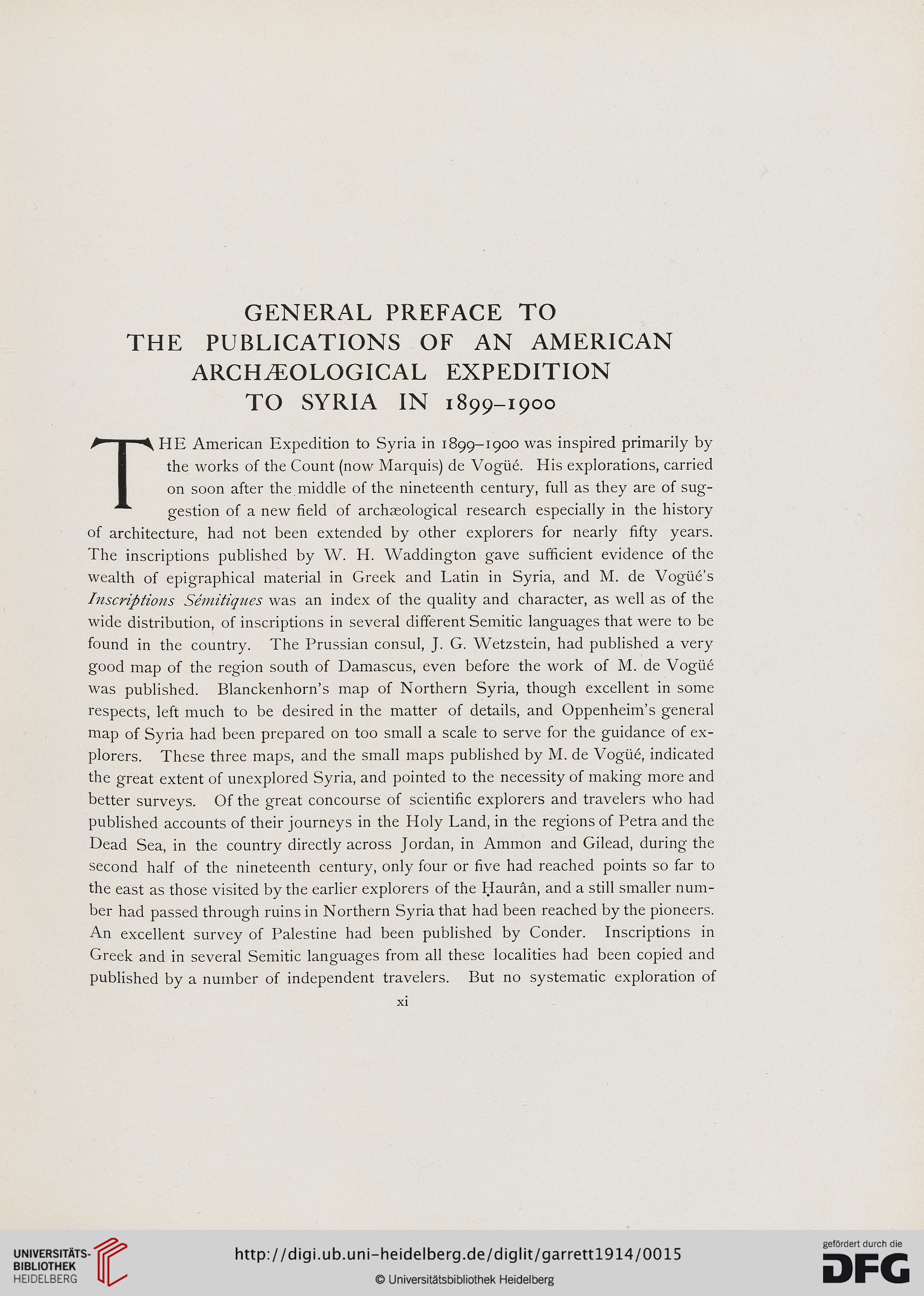GENERAL PREFACE TO
THE PUBLICATIONS OF AN AMERICAN
ARCHAEOLOGICAL EXPEDITION
TO SYRIA IN 1899-1900
HE American Expedition to Syria in 1899-1900 was inspired primariiy by
the works of the Count (now Marquis) de Vogue. His explorations, carried
on soon after the middle of the nineteenth century, full as they are of sug-
gestion of a new held of archaeological research especially in the history
of architecture, had not been extended by other explorers for nearly fifty years.
I he inscriptions published by W. H. Waddington gave sufficient evidence of the
wealth of epigraphical material in Greek and Latin in Syria, and M. de Vogue's
AD/V/hyv/Gy was an index of the quality and character, as well as of the
wide distribution, of inscriptions in several different Semitic languages that were to be
found in the country. The Prussian consul, J. G. Wetzstcin, had published a very
good map of the region south of Damascus, even before the work of M. de Vogue
was published. Blanckenhorn's map of Northern Syria, though excellent in some
respects, left much to be desired in the matter of details, and Oppenheim's general
map of Syria had been prepared on too small a scale to serve for the guidance of ex-
plorers. These three maps, and the small maps published by M. de Vogue, indicated
the great extent of unexplored Syria, and pointed to the necessity of making more and
better surveys. Of the great concourse of scientific explorers and travelers who had
published accounts of their journeys in the Holy Land, in the regions of Petra and the
Dead Sea, in the country directly across Jordan, in Ammon and Gilead, during the
second half of the nineteenth century, only four or five had reached points so far to
the east as those visited by the earlier explorers of the Hauran, and a still smaller num-
ber had passed through ruins in Northern Syria that had been reached by the pioneers.
An excellent survey of Palestine had been published by Conder. Inscriptions in
Greek and in several Semitic languages from all these localities had been copied and
published by a number of independent travelers. But no systematic exploration of
xi
THE PUBLICATIONS OF AN AMERICAN
ARCHAEOLOGICAL EXPEDITION
TO SYRIA IN 1899-1900
HE American Expedition to Syria in 1899-1900 was inspired primariiy by
the works of the Count (now Marquis) de Vogue. His explorations, carried
on soon after the middle of the nineteenth century, full as they are of sug-
gestion of a new held of archaeological research especially in the history
of architecture, had not been extended by other explorers for nearly fifty years.
I he inscriptions published by W. H. Waddington gave sufficient evidence of the
wealth of epigraphical material in Greek and Latin in Syria, and M. de Vogue's
AD/V/hyv/Gy was an index of the quality and character, as well as of the
wide distribution, of inscriptions in several different Semitic languages that were to be
found in the country. The Prussian consul, J. G. Wetzstcin, had published a very
good map of the region south of Damascus, even before the work of M. de Vogue
was published. Blanckenhorn's map of Northern Syria, though excellent in some
respects, left much to be desired in the matter of details, and Oppenheim's general
map of Syria had been prepared on too small a scale to serve for the guidance of ex-
plorers. These three maps, and the small maps published by M. de Vogue, indicated
the great extent of unexplored Syria, and pointed to the necessity of making more and
better surveys. Of the great concourse of scientific explorers and travelers who had
published accounts of their journeys in the Holy Land, in the regions of Petra and the
Dead Sea, in the country directly across Jordan, in Ammon and Gilead, during the
second half of the nineteenth century, only four or five had reached points so far to
the east as those visited by the earlier explorers of the Hauran, and a still smaller num-
ber had passed through ruins in Northern Syria that had been reached by the pioneers.
An excellent survey of Palestine had been published by Conder. Inscriptions in
Greek and in several Semitic languages from all these localities had been copied and
published by a number of independent travelers. But no systematic exploration of
xi




